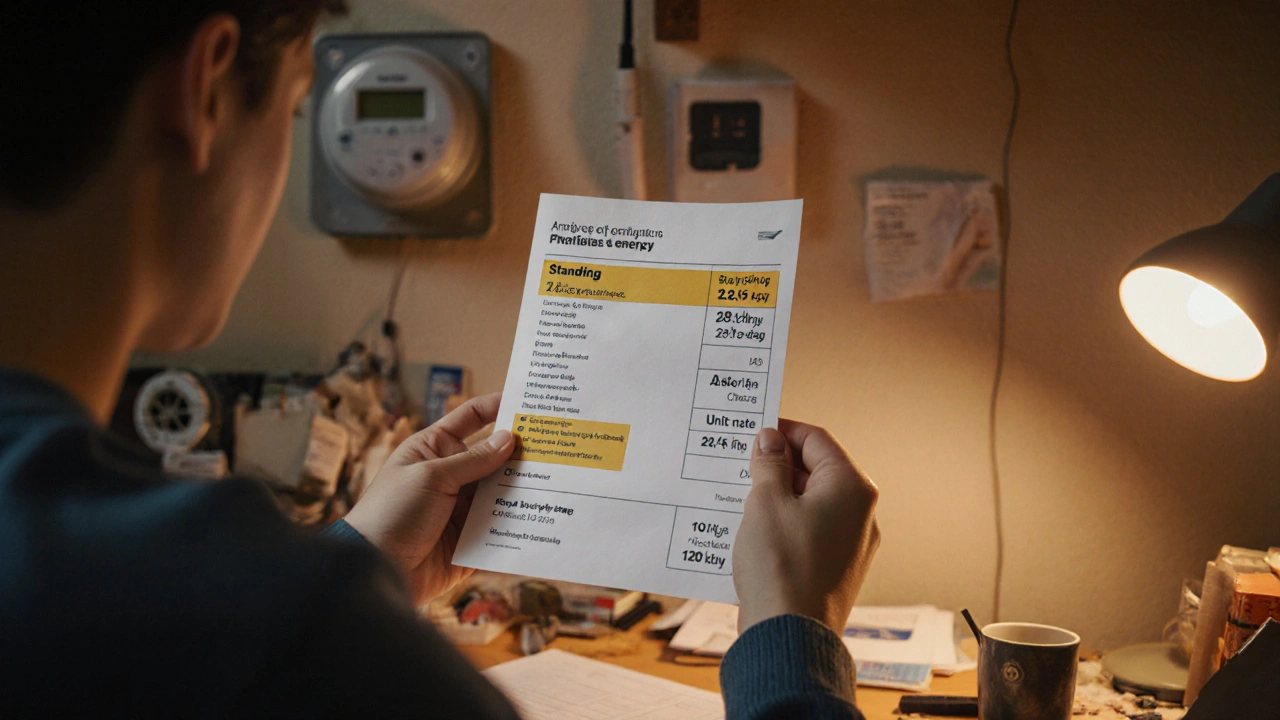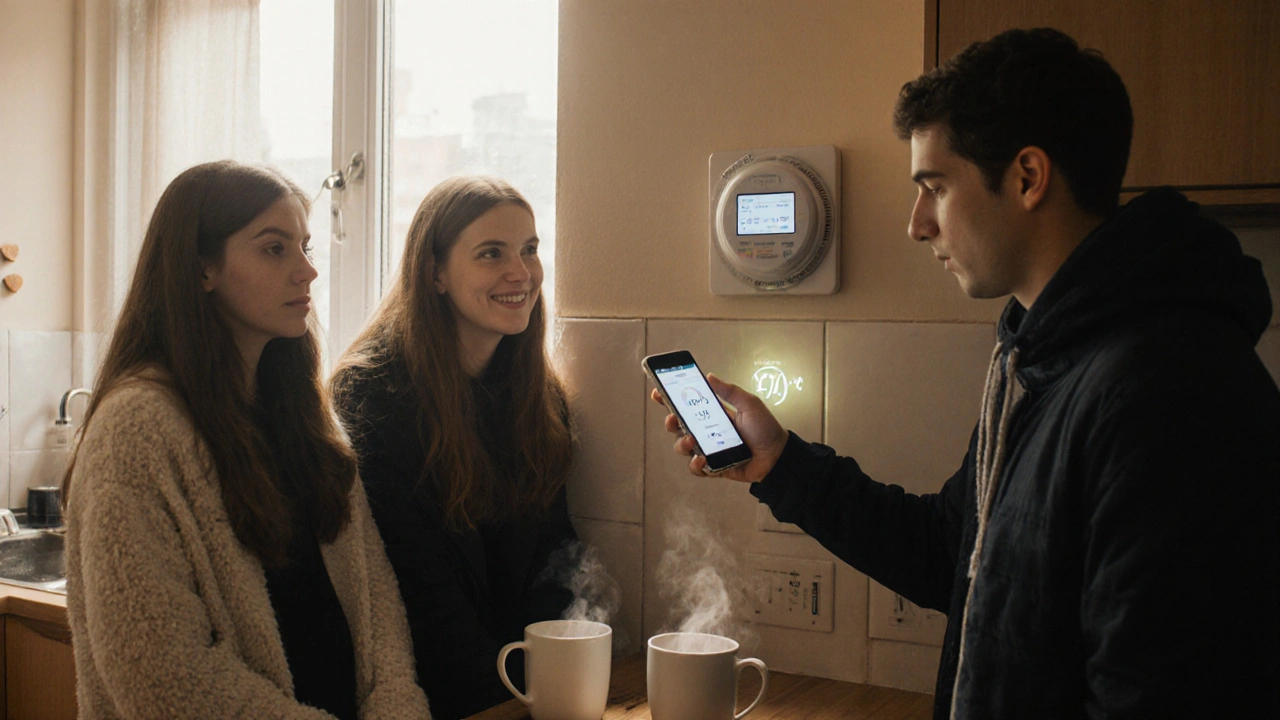
If you’re a student living in the UK, your energy bill can feel like a secret code. You see numbers, letters, and strange terms like "unit rate" and "standing charge"-and you’re not alone if you have no idea what they mean. But understanding your bill isn’t just about paying on time. It’s about knowing how much you’re really using, spotting errors, and saving money without cutting corners on heating or lighting. This guide breaks down exactly what each part of your UK energy bill means, using real examples you can follow step by step.
What’s on your energy bill? The basics
Your energy bill isn’t one single number. It’s made up of several parts, and each one affects your total cost. The most important pieces are:
- Standing charge - a daily fee you pay whether you use any energy or not
- Unit rate - how much you pay per kilowatt-hour (kWh) of gas or electricity you use
- Usage - how many kWh you’ve used over the billing period
- Payment amount - what you owe this month
- Previous balance - any leftover amount from last month
Let’s say your bill shows a standing charge of 29.5p per day for electricity and 7.5p per day for gas. That’s not a one-time fee. It adds up. Over 30 days, that’s £8.85 for electricity and £2.25 for gas - just for having the supply connected. No matter if you’re out at lectures all day, you still pay this.
Understanding unit rates: The real cost of using energy
The unit rate is where most students get confused. This is the price per kilowatt-hour (kWh) of electricity or gas you actually use. If your electricity unit rate is 24.5p per kWh, and you use 100 kWh in a month, you pay £24.50 for that usage alone.
Here’s a real example from a student in Manchester:
- Electricity used: 120 kWh
- Electricity unit rate: 24.5p/kWh
- Electricity cost: £29.40
Now compare that to a student in London on a different tariff:
- Electricity used: 120 kWh
- Electricity unit rate: 31.2p/kWh
- Electricity cost: £37.44
Same usage. £8 more just because of the rate. That’s why checking your unit rate matters. Many students end up on default tariffs after their fixed-term deal ends - and those are often the most expensive.
Standing charges: The silent cost
Standing charges are easy to ignore. They’re small. But they add up fast - especially if you’re on a plan with a low unit rate but a high daily charge.
Here’s a comparison between two plans:
| Feature | Plan A | Plan B |
|---|---|---|
| Electricity unit rate | 22.0p/kWh | 28.5p/kWh |
| Electricity standing charge | 45.0p/day | 15.0p/day |
| Gas unit rate | 5.5p/kWh | 6.8p/kWh |
| Gas standing charge | 25.0p/day | 10.0p/day |
If you use 100 kWh of electricity and 150 kWh of gas per month, Plan A looks cheaper on paper - until you do the math.
- Plan A total: £51.50 (electricity) + £25.50 (gas) + £18.00 (standing charges) = £95.00
- Plan B total: £43.50 (electricity) + £31.50 (gas) + £7.50 (standing charges) = £82.50
Plan B saves you £12.50 a month - even though its unit rates are higher. Why? Because the standing charges are much lower. For students who aren’t home all day, lower standing charges often mean lower bills.
Reading your usage: Spotting waste and saving money
Your bill shows how much energy you used in kWh. But how do you know if that’s normal?
A typical UK student flat (2-3 people) uses:
- Electricity: 80-150 kWh per month
- Gas: 100-200 kWh per month
If your electricity usage is over 200 kWh/month with no electric heating, you’re probably using too much. Common culprits:
- Leaving chargers plugged in 24/7
- Leaving the kettle on standby
- Using a space heater instead of turning up the central heating
- Leaving lights on in empty rooms
One student in Leeds cut her bill by 30% just by unplugging her laptop charger and turning off the TV at the wall. She didn’t change her habits - she just stopped wasting energy when things weren’t in use.
Check your bill for a graph showing daily usage. If you see spikes on weekends, you’re probably home more. If usage drops during term time, you might be on a fixed tariff that doesn’t match your schedule.
What to do if your bill seems too high
Here’s what to check if your bill feels wrong:
- Is it estimated? Look for "E" next to your usage numbers. Estimated readings can be way off. Submit a real meter reading through your provider’s app or website.
- Are you on a default tariff? If you’ve never switched, you’re likely on the most expensive plan. Use a comparison site like Uswitch or Energyhelpline to find cheaper deals.
- Is there a direct debit discount? Most providers offer 5-10% off if you pay by direct debit. If you’re paying by card or cash, you’re missing out.
- Did your supplier raise prices? Suppliers must notify you 30 days before a price increase. Check your email or account portal.
One student in Birmingham got a bill for £140 in November - way higher than usual. She checked her meter and found the supplier had estimated her usage for three months. She submitted the real reading. Her next bill dropped to £58.

How to lower your energy bill as a student
You don’t need to live in the dark to save money. Here are realistic ways students actually cut their bills:
- Switch to a fixed-term deal - Avoid default tariffs. Look for deals under 25p/kWh for electricity and 6p/kWh for gas.
- Use a smart meter - It gives you real-time usage data. Many students find they’re using more than they think.
- Share the bill - Split costs evenly with flatmates. Use apps like Splitwise to track who pays what.
- Apply for the Warm Home Discount - If you get certain benefits or your provider participates, you can get £150 off your bill. Check your provider’s website.
- Turn the thermostat down - Every 1°C drop saves about 10% on heating. Most students find 19°C is warm enough.
One group of four students in Glasgow switched from their supplier’s default tariff to a 12-month fixed deal at 21.8p/kWh. Their monthly bill dropped from £112 to £74 - a saving of £456 a year.
What to do if you can’t pay your bill
If you’re struggling to pay, don’t ignore it. Energy suppliers in the UK are required to help customers in financial difficulty. Contact them as soon as you can.
You can ask for:
- A payment plan - spread your bill over several months
- A reduction in direct debit
- Access to the Fuel Bank Foundation - they give emergency vouchers for energy
- Advice from Citizens Advice - free, confidential help with energy debt
Many students don’t know this, but suppliers can’t cut off your supply between October and March if you’re on a domestic tariff. Use that time to get help before winter hits.
Final tips: What to look for next time
Next time you get your bill, do this quick check:
- Find the standing charge - multiply it by the number of days in the billing period
- Find the unit rate - multiply it by your usage
- Add the two together - that’s your total before tax
- Check if it matches your total - if not, there’s an error
- Compare it to last month - is usage higher? Why?
Understanding your bill isn’t about becoming an expert. It’s about taking control. Most students pay too much because they assume it’s too complicated to change. But once you know what the numbers mean, you can save hundreds a year - without living in a cold flat.
Why is my standing charge so high?
Standing charges cover the cost of keeping your property connected to the energy network - pipes, wires, maintenance, customer service. Some suppliers charge more to offer lower unit rates. If you’re out a lot, a high standing charge can make your bill worse. Look for plans with lower daily fees, especially if you’re on a short-term contract.
Can I switch energy suppliers as a student?
Yes - and you should. Most student tenancies are 12 months, and you can switch suppliers anytime during that time. You don’t need permission from your landlord unless your contract says otherwise. Many suppliers offer student-friendly deals with no exit fees. Just make sure your new supplier supports your meter type (smart or standard).
What if my bill is based on an estimate?
If your bill says "E" next to your usage, it’s estimated. This often happens if your meter isn’t read for months. Submit your own reading through your supplier’s app or website. Once you do, your next bill will adjust - you’ll either get a refund or be asked to pay the difference. Always take a photo of your meter before submitting.
Is it cheaper to pay by direct debit?
Yes - most suppliers offer a 5-10% discount if you pay by direct debit. It also helps them predict your usage and avoid large bills. Even if your payments are fixed, you can still get the discount. If you’re paying by card or cash, you’re paying more than you need to.
How do I know if I’m on the cheapest tariff?
Compare your current unit rates and standing charges with what’s available on comparison sites like Uswitch or Energyhelpline. If your electricity rate is above 25p/kWh or your gas rate is above 7p/kWh, you’re likely paying too much. Switching can take less than 10 minutes online, and your new supplier handles the rest.